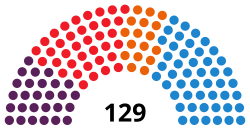Madrid Assembly
|
Assembly of Madrid Asamblea de Madrid |
|
|---|---|
 |
|
| Type | |
| Type | |
| Houses | Unicameral |
| Leadership | |
|
María Paloma Adrados Gautier, PP
|
|
| Structure | |
| Seats | 129 |
 |
|
|
Political groups
|
Government (48)
Supported by (17)
Opposition (64) |
| Elections | |
|
Last election
|
May 24, 2015 |
|
Next election
|
2019 |
| Meeting place | |
 |
|
| Chamber of the Madrid Assembly Plaza de la Asamblea, Madrid, Community of Madrid |
|
| Website | |
| www.asambleamadrid.es | |
Government (48)
Supported by (17)
Opposition (64)
Coordinates: 40°22′55.15″N 3°39′44.29″W / 40.3819861°N 3.6623028°W The Assembly of Madrid or Madrid Assembly (Spanish: Asamblea de Madrid) is the unicameral regional legislature of the Autonomous Community of Madrid since the approval of the Madrid Charter of Autonomy in 1983.
It is elected every four years during the Spanish Regional and Municipal elections, as the Community of Madrid Charter of Autonomy does not recognise the right to call early elections (as in the Basque Country, Catalonia, Galicia and Andalusia), save for exceptional situations like the scandal that deadlocked the May 2003 Assembly and forced fresh elections in October 2003. According to the Charter, the Assembly is empowered to draw the Madrid Regional legislation, to control the Regional Government's actions and to elect the President of the Community of Madrid.
The Assembly meets in the district of Vallecas of Madrid in a hall inaugurated in 1998 specifically designed to host the Madrid Assembly.
The legislature is currently (as of 2015[update]) made up of 129 deputies, elected all at once in closed party lists for terms of 4 years. Seats are allocated using the proportional D'Hondt method in one constituency, which makes the Madrid Assembly one of the biggest parliaments in the world with one only constituency. In 2007, this fact moved President Esperanza Aguirre to propose splitting the Community of Madrid into twelve constituencies of 9 to 15 AMs each. The alleged benefit was increasing the contact between statesmen and their electors, but the reform was rejected by the rest of parties in the Assembly on the grounds that it was not a pressing matter, and it would alter the composition of the assembly in favour of the most voted party. Eventually, the proposal was abandoned even though President Aguirre had the majority to pass it through the Assembly, because it would be defeated in the Cortes Generales as it had to be done through a process of reform of the Charter of Autonomy.
...
Wikipedia
